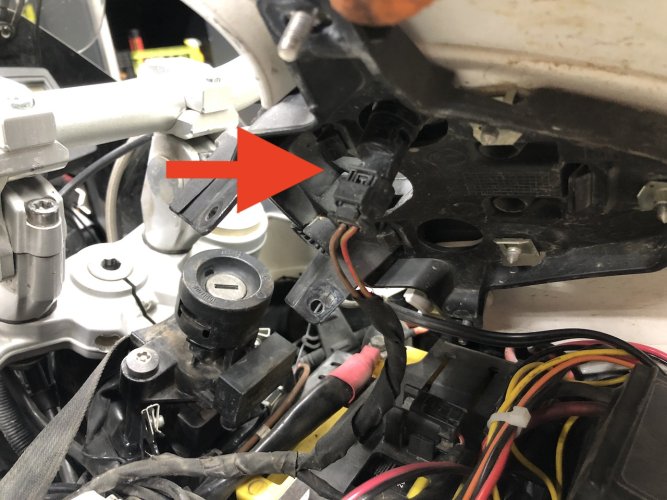The articles, posts and comments in this tech section are posted by individual members and reflect their personal thoughts and experiences with repairing, maintaining, and generally working on motorcycles. This information may require specific knowledge and skills, may or may not be correct or current to model.
The authors of information found here and the BMW MOA take no responsibility for ensuring the accuracy of any information (including procedures, techniques, parts numbers, torque values, tool usage, etc.), or further for any damage of any kind or injuries incurred or caused by anyone following the instructions or information found here.
It is the duty of the individual to either assume the liability himself for responsibly using the information found here, or to take the bike or accessory to a Dealer or other qualified professional service.
Please ensure you dispose of your used chemicals, oils and fuels in an environmentally responsible manner. Most Auto Parts stores and service stations will accept used oil and lubricants, tires and batteries, please check for your local availability. Here's a link where you can look up a place to dispose of your used fluids (oil, coolant, brake fluid, etc.) - http://earth911.com/
This article, text and photos are Copyright of the individual authors and the BMW MOA, any copying or redistributing is permitted only by prior written authorization.
PLEASE PRINT AND READ ALL THE INSTRUCTIONS BEFORE BEGINNING!
Final note: Batteries can be dangerous to you, people around you, and your motorcycle's sensitive electronics. Remove all metal jewelry before working. When in doubt, take your motorcycle to a reputable dealer.
------------------------------------------------------------------------------------------------------------------------------------------------------------------------------------
Removing or Changing the battery on your BMW F-Twin (F650, F700 and F800)
Note 1: The specific bike shown is a 2013 F800GS, but the battery removal should be applicable to all twin-cylinder F650, F700 and F800 bikes and models. How you get to the battery will be different on other styles of F-Twins (ST,GT)
Note 2: This F800GS has been heavily accessorized (farkeled), which results in many more battery connections and excess wires compared to a stock bike. This bike also has an aftermarket battery installed with two additional terminals.
Note 3: The tools and materials used are by personal choice and are not due to any affiliation with any brand
Tools Required:
- T25 star (Torx) bit
- T27 star bit
- 10mm socket (or equivalent that fits your specific battery terminals)
- Ratchet(s) that fit the above
The authors of information found here and the BMW MOA take no responsibility for ensuring the accuracy of any information (including procedures, techniques, parts numbers, torque values, tool usage, etc.), or further for any damage of any kind or injuries incurred or caused by anyone following the instructions or information found here.
It is the duty of the individual to either assume the liability himself for responsibly using the information found here, or to take the bike or accessory to a Dealer or other qualified professional service.
Please ensure you dispose of your used chemicals, oils and fuels in an environmentally responsible manner. Most Auto Parts stores and service stations will accept used oil and lubricants, tires and batteries, please check for your local availability. Here's a link where you can look up a place to dispose of your used fluids (oil, coolant, brake fluid, etc.) - http://earth911.com/
This article, text and photos are Copyright of the individual authors and the BMW MOA, any copying or redistributing is permitted only by prior written authorization.
PLEASE PRINT AND READ ALL THE INSTRUCTIONS BEFORE BEGINNING!
Final note: Batteries can be dangerous to you, people around you, and your motorcycle's sensitive electronics. Remove all metal jewelry before working. When in doubt, take your motorcycle to a reputable dealer.
------------------------------------------------------------------------------------------------------------------------------------------------------------------------------------
Removing or Changing the battery on your BMW F-Twin (F650, F700 and F800)
Note 1: The specific bike shown is a 2013 F800GS, but the battery removal should be applicable to all twin-cylinder F650, F700 and F800 bikes and models. How you get to the battery will be different on other styles of F-Twins (ST,GT)
Note 2: This F800GS has been heavily accessorized (farkeled), which results in many more battery connections and excess wires compared to a stock bike. This bike also has an aftermarket battery installed with two additional terminals.
Note 3: The tools and materials used are by personal choice and are not due to any affiliation with any brand
Tools Required:
- T25 star (Torx) bit
- T27 star bit
- 10mm socket (or equivalent that fits your specific battery terminals)
- Ratchet(s) that fit the above
Last edited:






